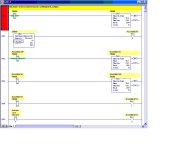cmcc60
Member
I am working on a program for class and the instructor is out of
town so I was wondering if anybody here can help. We use the Allen-Bradley PLC5 using DOS to program. I have a clock using a timer for the seconds, a counter(minutes), and another counter(hours). The accumulated values are MOVED to the 3 seperate INTIGER files. I use compare instrutions to turn 2 lights on but I do not know how to make light 3 blick for 15 minutes at 10:00.
town so I was wondering if anybody here can help. We use the Allen-Bradley PLC5 using DOS to program. I have a clock using a timer for the seconds, a counter(minutes), and another counter(hours). The accumulated values are MOVED to the 3 seperate INTIGER files. I use compare instrutions to turn 2 lights on but I do not know how to make light 3 blick for 15 minutes at 10:00.






